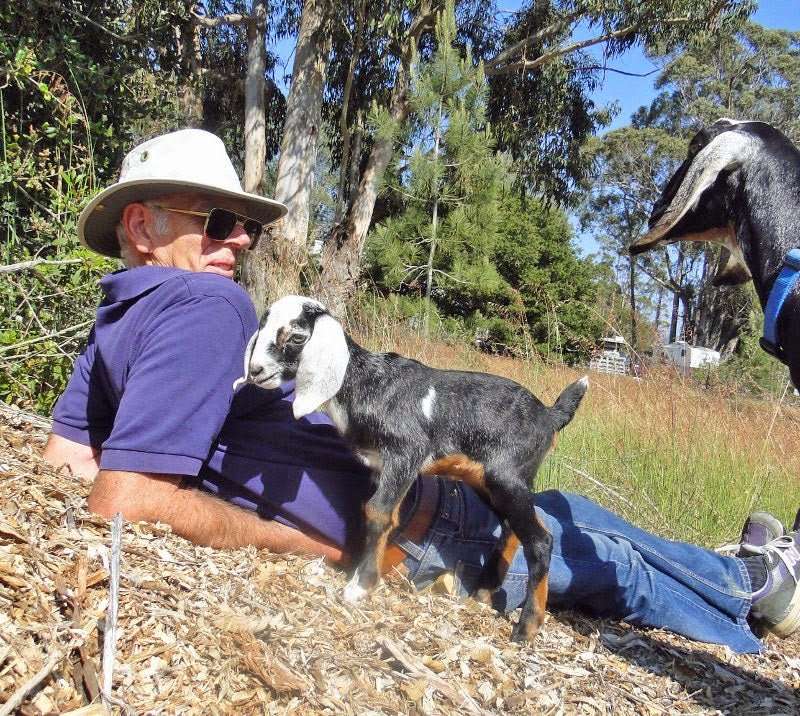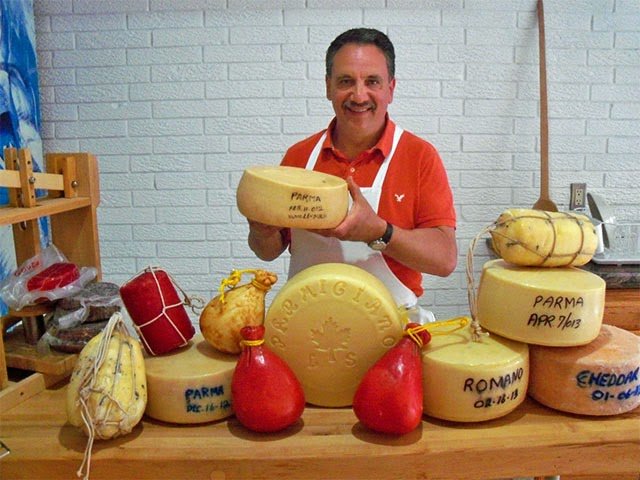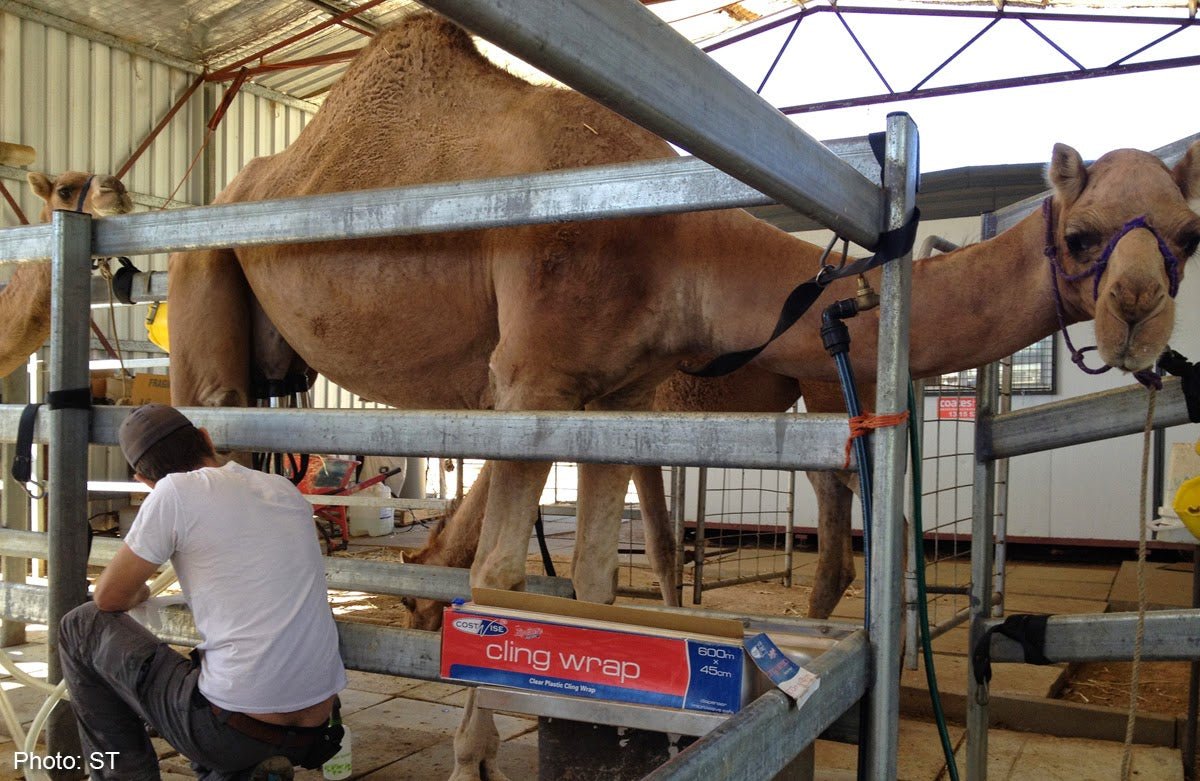Phil Tillman is a retired veterinarian, making goat’s milk cheese and living the good life on the coast of California. Up until 10 years ago, he worked in private practice and for the US Department of Agriculture and the University
of California. We came to know him when he entered our 35th Anniversary Essay Contest last December:
Time, Rain, and Cheese
Essay by Phil Tillman
“But if you retire, how will you structure your time?”
A good friend asked me this as I retired, just a decade ago. “Why on earth would I want to structure my time?” I thought. Retirement was going to be about freedom, not having a schedule, and doing what I wanted when I wanted. Then Rain came along.
We’d had goats before, just as pets. Rain was a spoiled little princess of a Nubian; she’d be a fun little pet and she’d help keep down the poison oak and other weeds. But she was a dairy goat; she had a purpose. I’d read Brad Kessler’s Goat Song and heard about New England Cheesemaking – when Rain had her first kid, I had to give it a shot. I’d just do it a couple of times, taking what milk her kid didn’t need. Rain gave more than a gallon per day and her single kid hardly put a dent in her production.
At first, all we made was chevre. Rain’s milk was sweet and wonderful, with no goat character whatsoever. On a piece of fresh baguette, with a little of Elaine’s homemade loganberry jam, a fresh cup of coffee, and the morning paper, her chevre made the sun shine on the foggiest of mornings.
After the chevre came yogurt (we use it in pancakes instead of buttermilk), then halloumi (our most spectacular hors d’oeuvre), feta (the best Greek salads ever), and Valencay (our most beautiful product). And nothing beats kefir on a hot day; it’s better than any milk shake.
When visiting friends, we used to bring a bottle of wine; now we bring a cheese. Our friends would say, “I don’t like goat cheese.” We’d say, “Neither do we, but try this.”
They lift a small bit to their mouth, preparing to grimace as they taste it, but, as the flavors soak in, the lines on their face soften. Then they get a look of amazement and say, “Oh my! This stuff is wonderful! Where can we buy this?” Our answer is always, “You can’t buy it; it’s just for our friends.”
While we can’t sell dairy products, Elaine, the merchant in the family, barters relentlessly; she has developed a cadre of farmers’ market vendors who will gladly swap their goods for a cheese to take home. Last week she came home from the farmers’ market with honey, olive oil, persimmons, fresh bread, and even albacore; all traded for Rain’s cheese.
So how do I structure my time in retirement? At sunrise, my “meadowlark,” the black one with hooves, sings for me, asking to be milked. Then she’s out to pasture and I bottle the morning’s milk, turn my aging cheeses, and figure out what to do with today’s gallon. Oh yes, and I have to play with the kids. Since we milk alongside the kids, I need to play with them every day so they are properly socialized.
It’s a tough life, but someone has to do it.
 |
| In the pasture with Eclair, Rain’s first kid. |
Interview
What’s new since you wrote your essay?
Rain has had two pregnancies. Her first was two years ago and was a
singleton, Eclair (doe). Her second pregnancy was the following year
and she had two kids, Lyle and Lily (buck and doe). I’ve been fortunate
in that I was able to sell both Eclair and Lily as dairy goats and was
able to place Lyle as a breeding buck.
I did not breed Rain last year,
thinking she would dry off in the fall, but here it is August and she’s
still going strong. I doubt I’ll breed her this fall either. I
anticipate she’ll begin to slack off this fall and then she and I will
both take a year off.
Does, especially does with good
breeding, are valuable as dairy animals. Most bucks, of course, wind up
being sold at auction as meat. If Rain ever has another buck, I’m
thinking of leaving the horns on and training him to be a pack goat. I
would have serious issue with my grandkids if I sold a buck they had
played with as cabrito.
This is Eclair’s first time to stand:
Some people say, “A nursed kid is a damned kid,” meaning that kids reared on the dam will never be properly socialized. The statement has it’s basis, but it’s not completely true. If you spend time with the kids, they’ll be tame. If you don’t spend time with the kids, they’ll be wild. Dam reared kids will be perfectly social if you spend enough time with them.
What bottle feeding does is force you to spend time with them. You can spend time with them without bottle rearing and it works just as well. I’d rather play with the kids than wash bottles, plus the kids do better with their mother taking care of them. Of course, if you had a large dairy and were working for a living, there might not be time enough in the day to socialize all the kids, so dam rearing might not be practical. For us, it’s a piece of cake.
This is me socializing Lily. Pretty arduous, as you can see.
The picture below is Rain, from her most flattering angle. She is a very well-bred
dairy goat, yielding 5 quarts per day in early lactation, and yielding 3 quarts
per day now, 15 months after kidding. I doubt she’ll dry any further
before November or so. Her claim to fame is that she has absolutely no
goat character in her milk whatsoever. You can keep her milk in the
fridge, unpasteurized for a week and you would still not have any idea
that it was goat milk – her milk is so rich, you’d probably think it came
from a Jersey.
What kinds of cheese are you making?
Mostly, I have made things that don’t require aging, such as yogurt, kefir, halloumi, chevre, feta, etc., due to my lack of a cave.
This one is Valencay (which you call “Ash Coated Chevre”). Here is one about a month old, ready to serve.
I also do an aged lactic cheese with Penicillium Candidum just like the above, but without the ash. The result is a bit like Brie and a bit like Camembert. I never know what to call it. When people ask, I tell them it’s an “aged chevre de pays, just like the one the rat finds at the beginning of the movie Ratatouille.”
Halloumi is probably my favorite to make and to show off. It’s also the single most time consuming cheese I make, so I usually only do it for company. I always use fresh mint on Halloumi, I must have taken this picture before I put the mint on.
And, we pretty much always use your heart shaped molds for chevre. Here are some chevres with some other produce from our garden.
Where are you aging your cheese?
I can age starting about October through about June by sealing off a
guest bedroom. I’ve got a makeshift cave set up in the guest shower.
By opening the window at night and closing it in the morning, I can
maintain temperatures in the guest shower down to about 56F.
I age on
shelving jury rigged out of unused floor tiles stacked on quart mason
jars. It sounds funky, but I can easily sanitize the whole area and the
temperature is very steady. I’ve never had a single contaminating
mold. Here is what it looks like:
How are you maintaining the humidity?
At first (as shown in the picture above), I had a shallow pan of water on the
floor of the shower outside the picture, in which there was a couple of
empty wine bottles (for height) with cotton towels draped over them. I
kept water in the pan and it wicked pretty rapidly up over the towels; I
had to add additional water about twice a day. I kept the shower door
closed which tended to contain (I think) moisture inside the shower
stall.
I never measured humidity, but things seemed to “work” in that I
never had a cracked cheese, nor did the p. candidum ever fail
to grow. This system was a bit of a maintenance issue, however. One
had to keep changing out and washing the towels, etc. Plus, I did not
want to have that much moisture constantly present in a bathroom.
I finally was able to find some made-in-USA food grade clear
polycarbonate serving boxes with lids. They make great ripening boxes
and I’ve used them ever since I found them.
They are made in Huntington Beach California by a company called “Cambro.” I
found these at a local restaurant supply store called “Smart and Final.” I put a
stainless steel rack in each one and put mats on the rack and I control
the humidity by keeping the lid slightly ajar. The size that works best
for me is the Cambro 14CW pan with a 10CWCH lid.
It really helps to have a decent drying rack. After lots of trial and error, the only good ones I’ve found are these:
http://www.surlatable.com/product/PRO-8771/Stainless+Steel+Baking+and+Cooling+Rack
They are outrageously expensive, but they are perfect and should last a
lifetime. It just so happens they exactly fit into the ripening boxes I mentioned. There is just enough clearance to allow a cheese made in
one of your basic molds to rest on one of your polypropylene mats on top of this rack (although taller ripening boxes than mine would be better). I have three boxes and three racks; with 4 cheeses per box, I could have a dozen cheeses running at once (I’ve never had that many going, but I’ve had six at a time).
The tough thing is finding a stainless rack. There are lots of chrome cookie racks, but the acidity rusts them and they contaminate the cheese.
What kind of press are you using?
I don’t use a press. I use your basic basket mold with the stainless steel follower I got from you; for weight, I use a couple of 16 oz. beans cans – two cans stacked on each follower.
What will you do for cheese when Rain dries?
Good question. I won’t make nearly as much. I’ve been milking every day for
most of the last 3 years, which means I can’t travel very easily. I
can get someone to feed easily, but I have not been successful in training
someone I can trust as a milker. (I’ve tried with a couple of
teen-agers, but that’s another story.)
For one thing, I’ll be more likely to buy cheese. We might actually experiment and
taste test some exotic types – right now we NEVER buy cheese.
We’ve gotten spoiled by the quality of what we can make ourselves, however,
so I’ll probably always do few products. Halloumi always wows guests.
We use a lot of yogurt and ours is so much better than what we buy, so
we’ll likely keep making it. There is actually a small sheep dairy not
far from here. I might try to get some milk from them to play with
(they don’t normally sell milk, but they might for a local).
I’ll probably keep doing cheese from time to time, but I won’t HAVE to make cheese
for a while. Right now, I absolutely have to make something every two
or three days; otherwise we have so much milk in the fridge there is
not room for anything else.
What other animals do you have?
Two goats – Rain and her room mate Harmony, 5 hens, and 1 rooster. Our dog died last year – we’ll get another eventually.
Rain’s room mate is Harmony. Harmony yields fleece rather than milk.
She is a Pygora. Goats need a companion. You always need at least two
goats.
What do you do when you’re not making cheese?
We live on California’s Central Coast, in unincorporated San Luis Obispo
county. This picture was taken about ten minutes from my house. Winters are
mild, summers are cold (high sixties) and windswept. View is Avila
Beach as seen from Ontario Ridge.
We live mostly in Torrey Pine forest. Our terroir is pine needles, eucalyptus bark, poison oak, and veldt grass.
Here is our Rooster Rene, with his ladies. He’s the size of a small dog. He is a Maran.
This shows some of my husbandry staff. Granddaughter Sophia and daughter Jean with Eclair. We’ve got 5 grand kids.
This is Sophia, grandson Joey, and Jean with Lily and Lyle, Rain’s last kids.
And this is my wife, Elaine, with the same kids.































































































































































